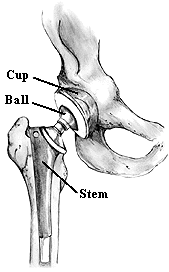The modern total hip replacement was invented in 1962 by Sir John Charnley, an orthopedic surgeon working in a small country hospital in England. His work has been one of the great triumphs of Twentieth Century surgery. Two revolutionary features of the Charnley hip replacement were 1) the combination of metal gliding on plastic, and 2) the use of methacrylate cement to attach the artificial components to the bone. The arthritic femoral head is removed. It is replaced with a metal ball which is attached to a metal stem. The stem is cemented into the hollow marrow space of the femur. The worn out hip socket is lined with a plastic socket, which is also cemented in place.
 The painful parts of the arthritic hip are thereby completely replaced with metal and plastic surfaces. The plastic socket has a very low frictional resistance, and a very low wear rate against the metal ball. Sometimes the femoral ball component is made of ceramic (aluminum oxide or zirconium oxide) rather than metal. Plastic has an even lower wear rate against ceramic.
The painful parts of the arthritic hip are thereby completely replaced with metal and plastic surfaces. The plastic socket has a very low frictional resistance, and a very low wear rate against the metal ball. Sometimes the femoral ball component is made of ceramic (aluminum oxide or zirconium oxide) rather than metal. Plastic has an even lower wear rate against ceramic.
Total hip replacement was first performed in the United States around 1969. Many hundred of thousands of replacements have been performed in the U.S. since then.
The operation has become fairly routine and is successful
around 96% of the time.
|
One of the first three American surgeons to perform this type of surgery was Charles O. Bechtol. He started a total hip replacement program in 1969 while he was professor of orthopedic surgery at UCLA. Dr. Huddleston studied hip and knee surgery with him for one year in 1975. The two later became partners in a practice restricted to total joint replacement. Dr. Bechtol retired in 1984 and Dr. Huddleston took over the practice, and merged the practice with the Southern California Orthopedic Institute in 1988.
The major long-term problem with cemented hip replacements is loosening of the bond between the implant and the bone. There are two problems associated with the cement. Firstly, in time it cracks and becomes fragmented, resulting in loosening. Secondly, the body reacts to the smaller fragments, and attempts to remove them, but unfortunately in the process also removes bone adjacent to the cement particles, leaving the bone structurally weakened. If the implant loosens, a second surgery may become necessary to reattach it. Much research is being done to try and solve the loosening problem. It is widely believed that the solution is to eliminate the cement. This has led to the development of the Cementless Hip Replacement in which the surface of the metal parts is porous, and looks like coral. Bone can grow into the metal pores and lock the implant into place without the use of cement. There are several manufacturers of cementless hip replacements.
The AML Total Hip Replacement is the most widely used cementless implant in the world, and has the longest track record (since 1978). Dr. Huddleston uses an AML type of non-cemented hip replacement. The long term results with the AML Hip have so far been extremely promising, especially in people with good bone quality. However, it will be at least ten years more before we will be certain that cementless hips are indeed superior to cemented hips.
Initially, the cementless hips were used in patients of all ages, but it was soon found that in people with soft bones (osteoporosis) the femur bone does not always bond to the porous metal.
For this reason it is generally agreed that cementing the femoral component
is the best course in patients over 70.
|
People in their 60's fall into an in-between category. For them the choice between a cemented and a cementless femoral component depends on the quality of their bones. This can usually be determined from their hip x-ray, but quite frequently a true assessment of bone quality can only be made at surgery. Dr. Huddlestonís final decision on the question of cement will be made in your best interest.
Young patients (under 60) are usually advised to have
cementless replacements in the belief that they will
ultimately outlast cemented ones.
|
On the other hand, uncemented socket components have been extremely successful, regardless of the patientís age. Cement is rarely used on sockets nowadays.
A combination of uncemented socket and cemented femoral
component is known as a hybrid (mixed) hip.
|
It is important for you to know that many other brands of cementless hip devices have not been as successful as the AML hip, and some designs have had a very poor track record indeed.
Bone grafts are occasionally needed to restore bone defects. If so, the bone may be obtained from the discarded femoral head, or from the pelvis, through a small separate incision. Occasionally it may be necessary to cut tendons in the groin (Adductor Tenotomy) if these tendons restrict hip motion. This is done through one or two separate half inch incisions in the groin.
It is possible to perform two hip replacements under the same anesthetic, but in general, Dr. Huddleston does not recommend it. If you need two hips replaced, a better course is to have the more painful hip replaced first, and to wait approximately 12 weeks before undergoing the second operation.
The painful parts of the arthritic hip are thereby completely replaced with metal and plastic surfaces. The plastic socket has a very low frictional resistance, and a very low wear rate against the metal ball. Sometimes the femoral ball component is made of ceramic (aluminum oxide or zirconium oxide) rather than metal. Plastic has an even lower wear rate against ceramic.